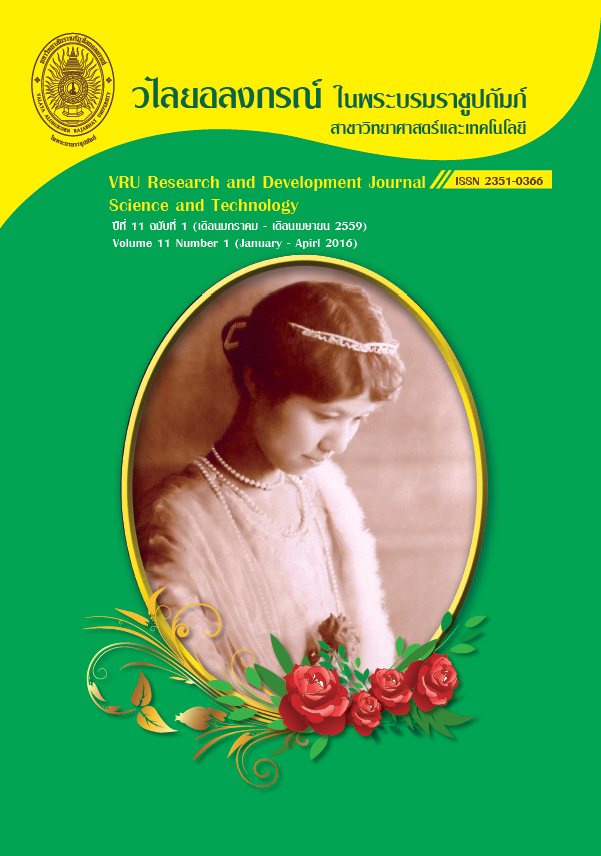การคัดเลือกและจัดจำแนกเชื้อแบคทีเรียที่สามารถผลิตเอนไซม์ไลเปสจากน้ำทิ้งโรงงานอุตสาหกรรม
Main Article Content
Abstract
การคัดเลือกแบคทีเรียที่สามารถผลิตเอนไซม์ไลเปสจากน้ำทิ้งโรงงานอุตสาหกรรมที่มีการปนเปื้อนของน้ำมันสามารถคัดเลือกเชื้อได้ทั้งสิ้น 22 ไอโซเลตจากการใช้อาหารเลี้ยงเชื้อที่มีการเติมน้ำมันมะกอกหรือน้ำมันปาล์มเป็นแหล่งคาร์บอน และเมื่อทำการคัดกรองเชื้อแบคทีเรียทั้ง 22 ไอโซเลตในอาหารเลี้ยงเชื้อ tributyrin พบว่ามีเชื้อแบคทีเรียเพียง 7 ไอโซเลตที่สามารถสังเคราะห์เอนไซม์ไลเปสชนิดหลั่งออกนอกเซลล์โดยพบการสร้างวงใสรอบโคโลนี โดยเชื้อแบคทีเรียไอโซเลต E2I1 มีการสร้างวงใสรอบโคโลนีได้ขนาดใหญ่ที่สุดตามด้วยไอโซเลต B1I1, E2I2, K2I2, E2I3, E2I4 และ E2I5 ตามลำดับ จากการจัดจำแนกเชื้อแบคทีเรียที่สามารถผลิตเอนไซม์ไลเปสชนิดหลั่งออกนอกเซลล์โดยการศึกษาลำดับนิวคลีโอไทด์ของยีนบริเวณ 16S rDNA รวมทั้งการเปรียบเทียบลำดับวิวัฒนาการพบว่า ไอโซเลต B1I1 และ K2I2 มีความใกล้เคียงกับแบคทีเรียสายพันธุ์ Pseudomonas fluorescens และ Pseudomonas sp. ในขณะที่เชื้อแบคทีเรียไอโซเลต E2I1, E2I2, E2I3, E2I4 และ E2I5 มีความสัมพันธ์ใกล้เคียงกับสายพันธุ์ Burkholderia cenocepacia, Acinetobacter junii, Rhizobium miluonense, Pseudoxanthomonas sp. และ Staphylococcus sp. ตามลำดับ
A total 22 bacterial isolates were screened for lipase production from the oil contaminated industrial wastewater using the enrichment medium supplemented with either olive or palm oil as a sole carbon source. The seven of twenty-two isolates were exhibited the clear zone after cultured on the tributyrin agar medium, indicating the relatively extracellular lipase production. The result confirmed, especially the isolate E2I1 proposed the greatest clear zone, followed by the isolate B1I1, E2I2, K2I2, E2I3, E2I4 and E2I5. Furthermore, the extracellular lipase producing bacteria were then identified according to the 16S rDNA determination and phylogenetic analysis. The molecular identification demonstrated the isolate B1I1 and K2I2 were shared the highest homology in order to Pseudomonas fluorescens and Pseudomonas sp. Moreover, the isolate E2I1, E2I2, E2I3, E2I4 and E2I5 were closely related to Burkholderia cenocepacia, Acinetobacter junii, Rhizobium miluonense, Pseudoxanthomonas sp. and Staphylococcus sp., respectively.
Downloads
Article Details
Copyright Notice
The copyright of research articles published in the VRU Research and Development Journal Science and Technology Journal belongs to the Research and Development Institute, Valaya Alongkorn Rajabhat University under the Royal Patronage. Reproduction of the content, in whole or in part, is prohibited without prior written permission from the university.
Responsibility
The content published in the VRU Research and Development Journal Science and Technology Journal is the sole responsibility of the author(s). The journal does not assume responsibility for errors arising from the printing process.
References
Anbu, P., Noh, M. J., Kim, D. H., Seo, J. S., Hur, B. K., & Min, K. H. (2011). Screening and optimization of extracellular lipases by Acinetobacter species isolated from oil-contaminated soil in South Korea. African Journal of Biotechnology, 10, 4147-4156.
Borkar, P. S., Bodade, R. G., Rao, S. R., & Khobragade, C. N. (2009). Purification and characterization of extracellular lipase from a new strain Pseudomonas aeruginosa SRT 9. Brazilian Journal of Microbiology, 40, 358-366.
Ertuğrul, S., Dönmez, G., & Takaç, S. (2007). Isolation of lipase producing Bacillus sp. from olive mill wastewater and improving its enzyme activity. Journal of Hazardous Materials, 149, 720-724.
Ghaima, K. K., Mohamed, A. I., & Mohamed, M. M. (2014). Effect of some factors on lipase production by Bacillus cereus isolated from diesel fuel polluted soil. International Journal of Scientific and Research Publications, 4, ISSN 2250-3153.
Gupta, N., Sahai, V., & Gupta, R. (2007). Alkaline lipase from a novel strain Burkholderia multivorans: Statistical medium optimization and production in a bioreactor. Process Biochemistry, 42, 518-526.
Houde, A., Kademi, A., & Leblanc, D. (2004). Lipases and their industrial applications: an overview. Applied Biochemistry and Biotechnology, 118, 155-170.
Kojima, Y. & Shimizu, S. (2003). Purification and characterization of the lipase from Pseudomonas fluorescens HU380. Journal of Bioscience and Bioengineering, 96, 219-226.
Kulkarni, N. & Gadre, R.V. (2002). Production and properties of an alkaline, thermophilic lipase from Pseudomonas fluorescens NS2W. Journal of Industrial Microbiology & Biotechnology, 28, 344-348.
Lane, D. J. (1991). 16S/23S rRNA sequencing In: Nucleic acid techniques in bacterial systematics (Stackebrandt, E. and Goodfellow, M., Eds.), pp. 115–175. Wiley, Chichester, UK.
Lee, L. P., Karbul, H. M., Citartan, M., Gopinath, S. C. B., Lakshmipriya, T., & Tang, T. H. (2014). Lipase-secreting Bacillus species in an oil-contaminated habitat: Promising strains to alleviate oil pollution. BioMed Research International, 2015, http://dx.doi.org/10.1155/ 2015/820575.
Liu, Y., Li, C., Meng, X., & Yan, Y. (2013). Biodiesel synthesis directly catalyzed by the fermented solid of Burkholderia cenocepacia via solid state fermentation. Fuel Processing Technology, 106, 303-309.
Liu, Y., Li, C., Wang, S., & Chen, W. (2014). Solid-supported microorganism of Burkholderia cenocepacia cultured via solid state fermentation for biodiesel production: Optimization and kinetics. Applied Energy, 113, 713-721.
Pogaku, P., Suresh, A., Srinivas, P., & Reddy, S. R., (2009). Optimization of lipase production by Staphylococcus sp. Lp12. African Journal of Biotechnology, 9, 882-886.
Saxena, R. K., Sheoran, A., Giri, B., & Davidson, S. W. (2003). Purification strategies for microbial lipases. Journal of Microbiological Methods, 52, 1-18.
Sharma, R., Chisti, Y., & Banerjee, U. C. (2001). Production, purification, characterization and applications of lipases. Biotechnology Advances, 19, 627-662.
Sirisha, E., Rajasekar, N., & Narasu, M. L. (2010). Isolation and optimization of lipase producing bacteria from oil contaminated soils. Advances in Biological Research, 4, 249-252.
Stathopoulou, P. M., Savvides, A. L., Karagouni, A.D., & Hatzinikolaou, D. G. (2013). Unraveling the lipolytic activity of thermophilic bacteria isolated from a volcanic environment. BioMed Research International, http://dx.doi.org/10.1155/2013/703130.
Tan, T., Lu, J., Nie, K., Deng, L., & Wang, F. (2010). Biodiesel production with immobilized lipase: A review. Biotechnology Advances, 28, 628-634.
Treichel, H., Oliveira, D. D., Mazutti, M. A., Luccio, M. D., & Oliveira, J. V. (2010). A review on microbial lipases production. Food and Bioprocess Technology, 3, 182-196.
Veerapagu, M., Narayanan, A. S., Ponmurugan, K., & Jeya, K. R. (2013). Screening selection identification production and optimization of bacterial lipase from oil spilled soil. Asian Journal of Pharmaceutical and Clinical Research, 6, 62-67.
Winayanuwattikun, P., Kaewpiboon, C., Piriyakananon, K., Chulalaksananukul, W., Yongvanich, T., & Svasti, J. (2011). Immobilized lipase from potential lipolytic microbes for catalyzing biodiesel production using palm oil as feedstock. African Journal of Biotechnology, 10, 1666-1673.
Wu, H. S, & Tsai, M. J. (2004). Kinetics of tributyrin hydrolysis by lipase. Enzyme and Microbial
Technology, 35, 488-493.


